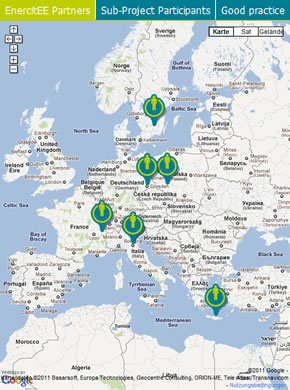GRACE – Analysis of funding programmes for citizens and communities
In Germany and especially in Saxony there are many funding programmes which support the energy efficiency of citizens and communities. Within the EnercitEE sub-project GRACE three funding programmes will be analysed in detail. The aim is to find out the effect of the programmes in that way that we are able to make a statement how many CO2 emissions respectively energy is saved with 1 € out of the funding programme.
One of the selected programmes is the Saxon Passive house programme. It is part of the Saxon Energy and Climate Protection Programme. The Passive house programme supports builders of passive houses with a grant of 100 €/m² based on the energy reference area. For refurbishment of buildings with passive house components the beneficiaries get a grant of 130 €/m² energy reference area. Both grants are non repayable. In Saxony the Passive house programme was used by 136 beneficiaries since 2007. In comparison with the standard EnEV building the passive house saves much more energy. The EnEV house is a standard in Germany. All builders of new houses have to follow this regulation. An amendment of this standard is planned for 2012, which means stricter rules for future homeowners. In the diagram below, there is a comparison between an EnEV house of 2009 and a passive house with 150 m² each. In addition it is assumed that the rate of energy price increase has a level of 5 % per year. All in all the beneficiary saves more than 20,000 € until year 30 after building and nearly 90,000 € until year 50 after building the passive house in that scenario.

Policy maker exchange – mayors from the EnercitEE partner regions will travel to Växjö, Sweden
From 30 May to 01 June 2012 the city of Växjö in Smaland, Sweden welcomes interested mayors from the different EnercitEE partner regions to provide an inside into its climate protection and energy policy and its vision to become a fossil fuel free city until 2030. The city of Växjö has been called “the greenest city of Europe” by many journalists, a recognition for its visionary sustainability strategy.
During the 2 day meeting the mayors will learn why and how Växjö’s vision could have been and will be implemented that successfully. Furthermore they will be presented exemplary energy efficiency measures and solutions in the fields of transport, heat/cooling generation and – distribution, public participation and future strategies that have already been carried out by the city, such as:
Cycle lanes/ boxes
Most CO2 emissions arise in the transport sector. That is why the city fosters the use of bicycles. A map illustrates the 150 km of cycle paths.
Free parking – for biogas, REM, DME, electrical and hybrid cars
This is an incentive to encourage people to use environmentally friendlier cars.
Bus station – biogas bus
The buses in Växjö are run with biogas produced in the sewage treatment plant in Växjö.
How to deal with a passive house?
Living or working in a passive house is a challenging novelty. EEMTE partner city of Leipzig set the passive house as a standard for newly erected and – if economic efficiency is given – for refurnished buildings. Since the use of passive house requires specific knowledge, staff working in these buildings has to be trained to optimize their benefits.
RIEEB partners will meet in Sweden
This week partners from Sweden, Germany, Poland and France will meet in the South of Sweden to discuss how far we have come in the RIEEB-project. The main item on the agenda is the validation tool that each country uses to confirm that calculated energy targets are met in real-life.
RIEEB Workshop on 24 June 2011 in Leipzig

On 24 June 2011 the Saxon Energy Agency as Lead Sub-Project Participant of the EnercitEE sub-project RIEEB organised the first practical workshop on “Building with Passive House components”. The “Westbad Leipzig” served as the perfect venue since the building shows how future energetic requirements in the building sector will be implemented.
Since 2003 the “Westbad Leipzig” has been rebuilt to a Health Care and Sport Center. The middle part of the complex of buildings will be reconstructed in the passive house style. The very low rest of the whole building’s thermal heat demand of 6 kWh/(m²a) will be provided by a gas-fired condensing boiler. After the reconstruction the middle part will host “Assisted living” and doctor’s offices.






